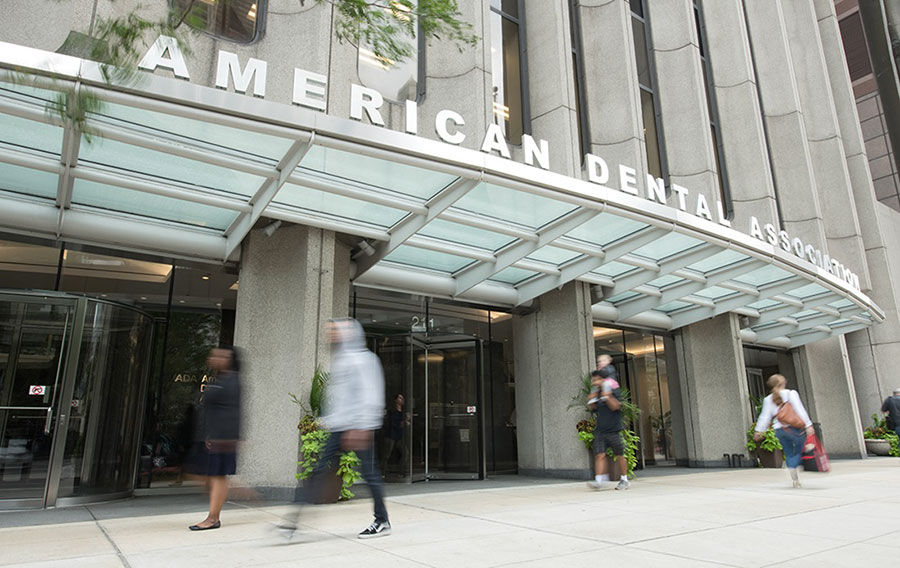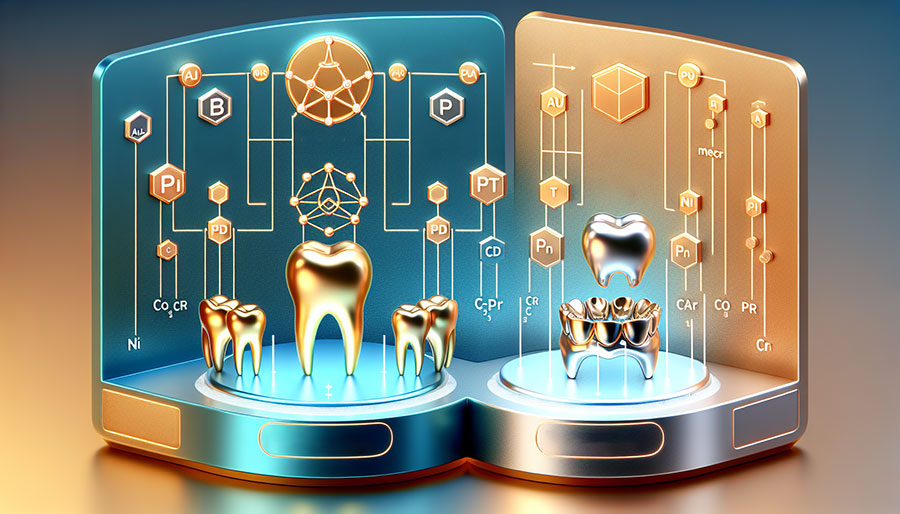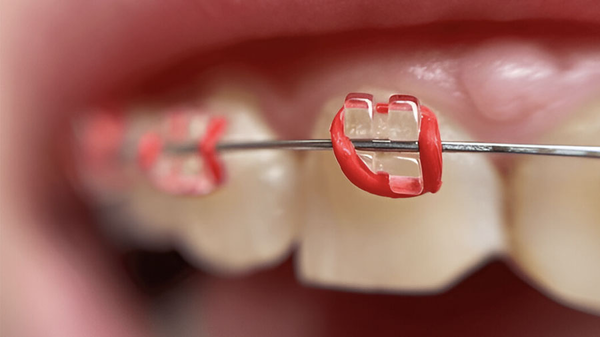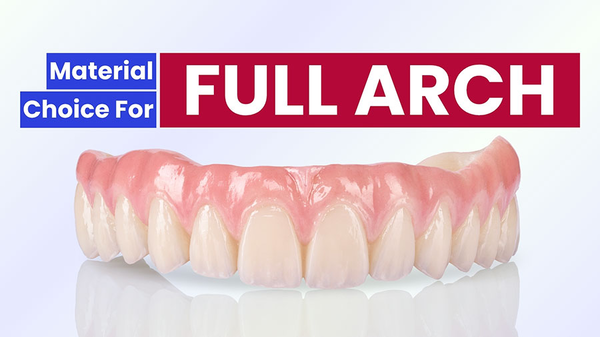Dental metal alloys are fundamental materials in dental laboratory technology, widely used for fabricating crowns, bridges, partial denture frameworks, and implant components. These materials are chosen for their strength, durability, biocompatibility, and ability to be precisely manipulated for various prosthetic applications.
Table of contents [Show]
Dental metal alloys are fundamental materials in dental laboratory technology, widely used for fabricating crowns, bridges, partial denture frameworks, and implant components. These materials are chosen for their strength, durability, biocompatibility, and ability to be precisely manipulated for various prosthetic applications. The American Dental Association (ADA) has established specific classification systems and standards to ensure the quality, safety, and performance of these dental alloys.
ADA Classification System

The ADA classifies dental alloys into three categories based on their noble metal content:
High Noble Alloys (HN)
Noble metal content: ≥60% by weight.
Gold content: ≥40% by weight.
Composition: Gold, platinum, palladium, and other noble metals.
Examples: Type III and IV gold alloys.
Noble Alloys (N)
Noble metal content: ≥25% by weight.
No gold content required.
Composition: Primarily palladium-based or silver-palladium alloys.
Examples: Pd-Ag, Pd-Cu-Ga alloys.
Noble metal content: <25% by weight.
Composition: Nickel-chromium (Ni-Cr) or cobalt-chromium (Co-Cr) alloys.
Examples: Ni-Cr-Mo, Co-Cr-Mo alloys.
Classification by Hardness (ANSI/ADA Specification No. 5)
The ADA further classifies dental casting alloys into four types based on hardness and clinical application:
Type I - Soft
Vickers Hardness: 50-90 HV.
Applications: Simple inlays, low-stress areas.
Yield Strength: 80-180 MPa.
Type II - Medium
Vickers Hardness: 90-120 HV.
Applications: Inlays, onlays, single crowns.
Yield Strength: 180-240 MPa.
Type III - Hard
Vickers Hardness: 120-150 HV.
Applications: Crowns, short-span bridges.
Yield Strength: 240-300 MPa.
Type IV - Extra Hard
Vickers Hardness: >150 HV.
Applications: Long-span bridges, removable partial denture (RPD) frameworks.
Yield Strength: >300 MPa.
Composition of Major Alloy Groups

High Noble Gold-Based Alloys
Au-Pt-Pd System Composition
Gold (Au): 70-85%.
Platinum (Pt): 8-12%.
Palladium (Pd): 2-5%.
Silver (Ag): 5-15%.
Copper (Cu): 2-5%.
Zinc (Zn): 0.5-2% (grain refiner).
Properties
Excellent corrosion resistance and biocompatibility.
Easy to cast and finish.
Warm yellow color.
High density (15-18 g/cm³).
Noble Palladium-Based Alloys
Pd-Ag System Composition
Palladium (Pd): 50-60%.
Silver (Ag): 25-40%.
Indium (In): 2-5%.
Gallium (Ga): 5-8%.
Tin (Sn): 2-5%.
Pd-Cu-Ga System Composition
Palladium (Pd): 75-80%.
Copper (Cu): 10-15%.
Gallium (Ga): 5-10%.
Gold (Au): 2-5%.
Properties
White/silver color.
Lower density than gold alloys.
Good mechanical properties.
Potential for discoloration with silver-containing alloys.
Nickel-Chromium (Ni-Cr)
Nickel (Ni): 60-70%.
Chromium (Cr): 15-25%.
Molybdenum (Mo): 3-6%.
Beryllium (Be): 0-2% (controversial).
Aluminum (Al): 2-4%.
Cobalt-Chromium (Co-Cr)
Cobalt (Co): 55-65%.
Chromium (Cr): 25-30%.
Molybdenum (Mo): 4-6%.
Tungsten (W): 2-5%.
Silicon (Si): 1-2%.
Physical and Mechanical Properties
Comparative Properties Table
Property | High Noble | Noble (Pd) | Ni-Cr | Co-Cr |
| Density (g/cm³) | 15-19 | 10-11 | 7.8-8.5 | 8.3-8.8 |
| Melting Range (°C) | 900-1050 | 1100-1300 | 1250-1350 | 1350-1450 |
| Elastic Modulus (GPa) | 80-100 | 100-120 | 180-210 | 200-230 |
| Yield Strength (MPa) | 200-600 | 300-800 | 400-1000 | 500-1200 |
| Elongation (%) | 10-35 | 10-25 | 8-20 | 8-15 |
| Vickers Hardness | 100-350 | 150-400 | 200-450 | 300-500 |
Corrosion Resistance
Noble Alloys
Tarnish resistance: Excellent.
Corrosion rate: <0.1 μm/year.
Ion release: Minimal.
Tarnish resistance: Good (due to Cr₂O₃ passive layer).
Corrosion rate: 0.1-1.0 μm/year.
Ion release: Possible Ni, Cr, and Co ions.
Laboratory Processing Techniques
Lost Wax Casting Process
Wax Pattern Formation
Proper spruing technique (8-10 mm diameter).
Sprue angle: 45-60°.
Investment Procedures
Phosphate-bonded investment for base metals.
Gypsum-bonded investment for noble alloys.
Casting Parameters
Centrifugal casting: Common.
Vacuum-pressure casting: Better density.
CAD/CAM Milling
Pre-sintered Blocks
Softer, easier to mill.
Requires sintering post-milling.
Fully Sintered Blocks
Harder, no post-processing required.
Selective Laser Melting (SLM)
Layer thickness: 20-50 μm.
Laser power: 200-400W.
Clinical Applications
Fixed Prosthodontics
Single crowns and short-span bridges (Type III alloys).
Long-span bridges (Type IV or base metal alloys).
Removable Prosthodontics
Co-Cr frameworks for partial dentures.
Light weight with high strength.
Implant Prosthodontics
Custom abutments with noble or titanium alloys.
Surface Treatments and Finishing
Mechanical Finishing
Polishing sequence: 600 to 1200 grit, followed by rouge polish.
Electrochemical Treatments
Electropolishing for smooth surfaces.
Passivation for chromium oxide layer formation.
Surface Modifications
Sandblasting (50-110 μm Al₂O₃).
Oxidation for porcelain bonding.
Economic Considerations
Material Costs (2024 Estimates)
High noble alloys: $50-80/g.
Noble alloys: $20-40/g.
Ni-Cr alloys: $0.50-2/g.
Co-Cr alloys: $1-3/g.
Recent Advances and Future Trends

New Alloy Development
Titanium alloys (Ti-6Al-4V, Ti-Zr) for biocompatibility and MRI compatibility.
Digital Manufacturing
Advanced CAD/CAM systems and 3D printing for precision and efficiency.
Surface Engineering
Nano-coatings for wear resistance and antimicrobial surfaces.
Conclusion
Dental metal alloys remain indispensable in dental laboratory technology, offering strength, durability, and versatility across a wide range of prosthetic applications. As materials science and manufacturing technologies advance, dental laboratories must adapt to new techniques and maintain rigorous quality standards to ensure optimal patient outcomes. By combining traditional expertise with emerging digital innovations, the future of dental alloys promises improved efficiency, precision, and biocompatibility.
XDENT LAB is an expert in Lab-to-Lab Full Service from Vietnam, with the signature services of Removable & Implant, meeting U.S. market standards – approved by FDA & ISO. Founded in 2017, XDENT LAB has grown from local root to global reach, scaling with 2 factories and over 100 employees.. Our state-of-the-art technology, certified technicians, and commitment to compliance make us the trusted choice for dental practices looking to ensure quality and consistency in their products.

Our commitments are:
100% FDA-Approved Materials.
Large-Scale Manufacturing, high volume, remake rate < 1%.
2~3 days in lab (*digital file).
Your cost savings 30%.
Uninterrupted Manufacturing 365 days a year.
Contact us today to establish a strategy to reduce operating costs.
--------❃--------
Vietnam Dental Laboratory - XDENT LAB
🏢 Factory 1: 95/6 Tran Van Kieu Street, Binh Phu Ward, Ho Chi Minh City, Vietnam
🏢 Factory 2: Kizuna 3 Industrial Park, Can Giuoc Commune, Tay Ninh Province, Vietnam
☎ Hotline: 0919 796 718 📰 Get detailed pricing
Share this post:
Related Posts

Discover the properties, benefits, and limitations of polycarbonate brackets in orthodontics. Learn how advancements in material science are enhancing aesthetic and functional performance.

Polymer brackets explained: From material composition to clinical performance, learn how these aesthetic braces are advancing orthodontics.

Material selection in full arch implant-supported restoration defines both functional success and clinical longevity. Learn about the key variables influencing material choice, common materials used i...


